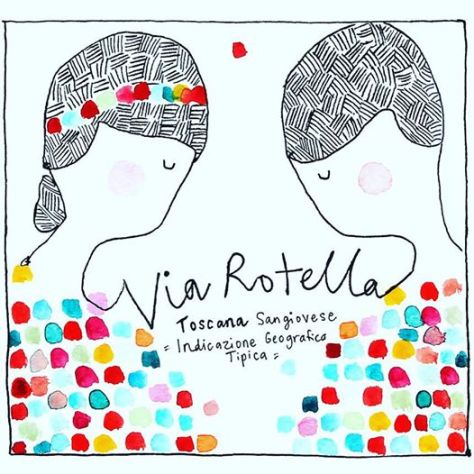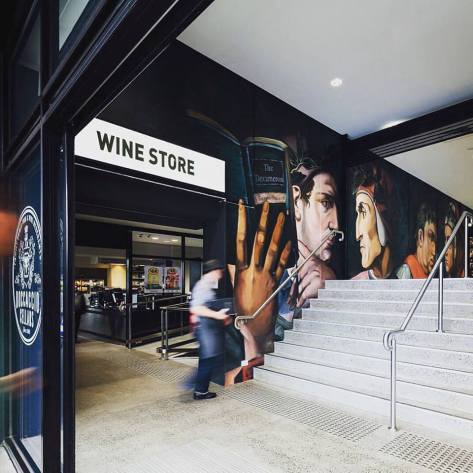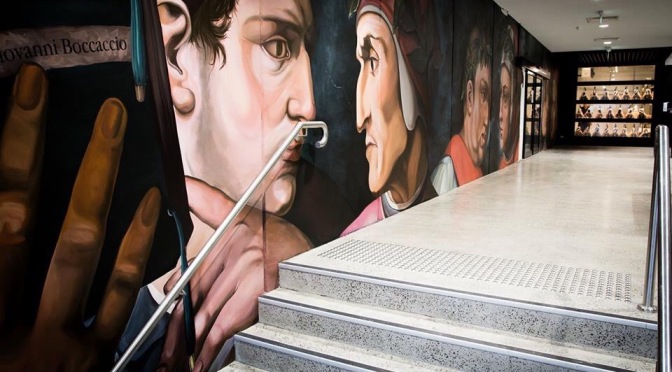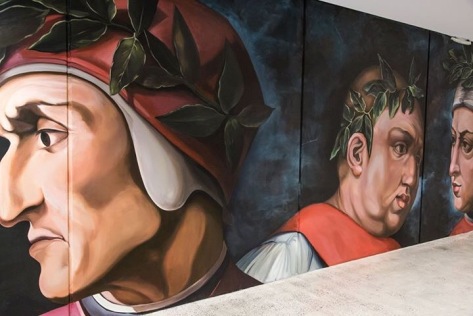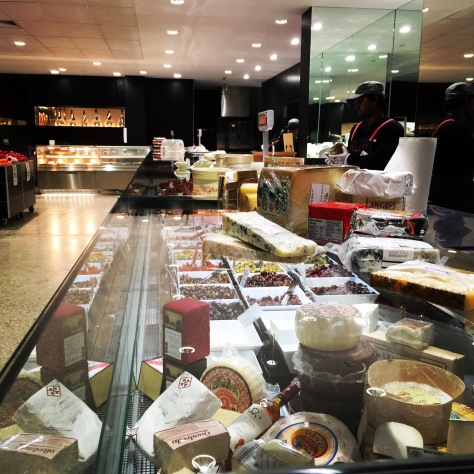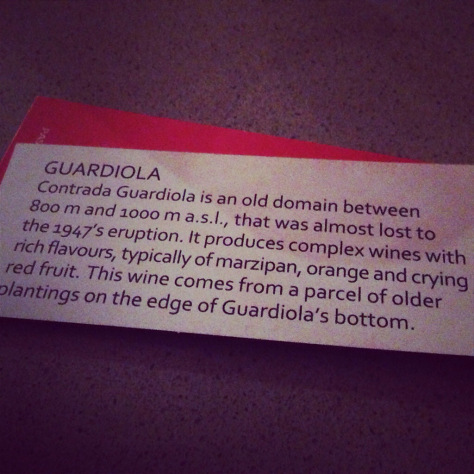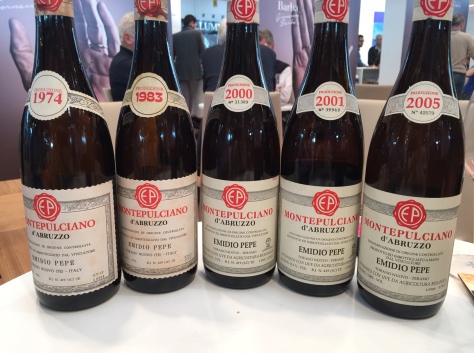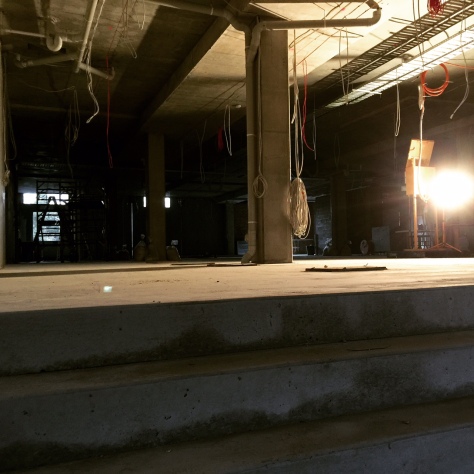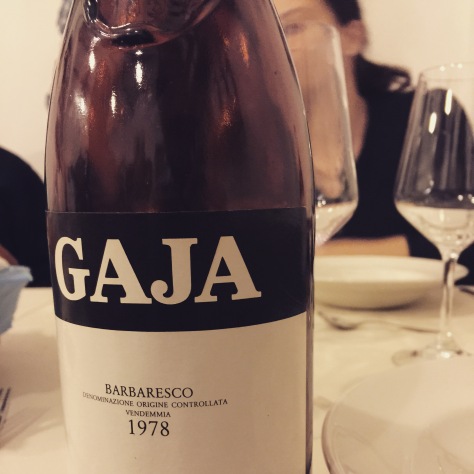 Last Thursday, a fellow group of wine lovers got together to look at 13 vintages of Gaja Barbaresco spanning 5 decades. Both wines and food were in top form and look at so many wines from a producer like Gaja, allowed us to see the evolution of style from the Gaja family. The conclusion was that the just released 2011 has almost seen a return to style of the very early Gaja Barbaresco’s where the fruit is allowed to play a dominant role, rather than fruit and oak. See below, notes on the wines. I have tried to include other reviewer and winemaker notes to give you a comparison My notes are in italic.
Last Thursday, a fellow group of wine lovers got together to look at 13 vintages of Gaja Barbaresco spanning 5 decades. Both wines and food were in top form and look at so many wines from a producer like Gaja, allowed us to see the evolution of style from the Gaja family. The conclusion was that the just released 2011 has almost seen a return to style of the very early Gaja Barbaresco’s where the fruit is allowed to play a dominant role, rather than fruit and oak. See below, notes on the wines. I have tried to include other reviewer and winemaker notes to give you a comparison My notes are in italic.  13 vintages of Gaja Barbaresco spanning 5 decades.
13 vintages of Gaja Barbaresco spanning 5 decades.
Strikingly profound and built to live for decades, Gaja’s wines display opulence and elegance unmatched elsewhere in Italy. These wines, while harnessing modern technology, have a long-established track record, ensuring they will perform well both in the glass and on the auction block. For any collector considering Italian wines, Gaja should be the first name on the list.
Gaja Barbaresco Barbaresco DOCG Produced in Barbaresco, Treiso and Neive, Barbaresco is one of the great wines of Piemonte. Cultivated in Piedmont since the 13th century, Nebbiolo plays a principal role in the winemaking culture of the region. It is a late maturing grape which is very sensitive to different soils and climates, resulting in a fascinating range of flavors that are affected by the subtleties of the area’s microclimates. While much smaller than the Barolo area, Barbaresco benefits from the influence of the Tanaro river which results in Nebbiolo that ripens earlier and has a lighter character. WINES ON THE NIGHT: 1967 Giacomo Conterno’s 1967 Barolo was awesome. It was similar to the Gaja in the depth of its fruit, but with a more balsamic profile of mint, leather, spices and tar. During this era Conterno sourced fruit from Monforte and Serralunga, and this Barolo revealed the heft that is the hallmark of those villages. Notwithstanding the wine’s masculinity, the finish was sweet, long and sublime. This was an exceptional bottle. 92 points Antonio Galloni Sweet and stellar. Classic Gaja with beautifully balanced tannins and fruit. 1973 The 1973 vintage helped to show us the ability of vineyards with the best exposure. Some crus are very good, not outstanding, but quite good. Angelo Gaja Again fantastic tannins and fruit. Lovely wine. Still some years ahead of it and very impressive. 1974 This vintage was celebrated as a great vintage but in fact it was a good vintage, with a large crop. It was close to 1964 but less quality. The crop was large. The harvest time was very long and lasted through November. Angelo Gaja Past it’s best. The ’75 runs rings around it. This has lost it’s fruit and is started to fade away.  1975 Amazing colour and complexity. Floral, perfumed and alive. Absolutely love it. Note that this wine faded very quickly after starting so strong. Maybe a slight hint of TCA but for me it didn’t affect the quality of the fruit that you could see. 1977 Lovely. Perfect Barbaresco. Savoury and tannic. A great example of aged Barbaresco. 1987 Seems like there has been a stylistic change with the ’87. Darker in colour and fruit weight. More brooding and oak more obvious. Not exactly my style. 1994 Classic wine. Clean, dark fruit but well structured This will have the capacity to live for a long time. 1996 The 1996 Barbaresco exhibits a dense ruby color as well as a forward nose of cherry liqueur, earth, truffle, mineral, and spicy scents. Rich, full-bodied, and seductive, with its moderate tannin largely concealed by the wine’s wealth of fruit and extract, this gorgeously pure offering gets my nod as the finest Barbaresco produced by Gaja since 1990. Anticipated maturity: 2002-2016. As I reported in issue #124 (8-27-99), 1996 is a spectacular vintage for Angelo Gaja. 90 points Robert Parker Wine Advocate #130 Aug 2000 Not a great bottle of ’96. Starting to age and fall away where great bottles should still be going strong. 1998 Full, deep red-ruby. Pungent floral/spicy aromas of black raspberry, tar, dark chocolate and marzipan. Juicy and very intensely flavored, with brilliant acidity giving the wine brightness and grip. Superb fruit really expands in the mouth. Boasts superb backbone for this bottling, which I almost referred to as Gaja basic Barbaresco. Very long, vibrant aftertaste. 91-93 points, Steven Tanzer, Vinous 1998 is one of my favorite vintages. It is a vintage of balance, beautiful balance. But after 1996 and 1997, 1998 was forgotten. But it is one of the most drinkable wines in the last thirty years. Excellent balance. Perfect to match with food. Because Piedmont produces food wines. Angelo Gaja Youthful, classic fruit and tannin. This still has 20 years ahead of before it get’s somewhere close to it’s drinking window. Lovely sweet tannins. 1999 Medium ruby. Gaja’s 1999 Barbaresco opens with a delicate, perfumed nose followed by sweet red fruit, tar, licorice, wet earth and smoke flavors with excellent length and overall harmony although it can’t quite match the sheer appeal of the 2000 and 2001 versions. With some air it is approachable now, although a few years of cellaring will be beneficial. It should drink well to age twenty. 91 points, Antonio Galloni, Vinous A classic vintage, very good. Rough tannin in the beginning but it’s now beginning to open. Angelo Gaja 15 years old and still another 15 years away from being ready. Again another fantastic wine that is going to age so well. Don’t be in a rush to drink these if time is on your side. 2004 The 2004 Barbaresco reveals fresh, perfumed aromatics that lead to layers of crushed flowers, spices and sweet raspberries. this is a wine of rare class, elegance and pure breed. It offers outstanding length and silky, elegant tannins to round out the inviting finish. 93 points Antonio Galloni Another vintage close to 1964. Good crop and a good combination of harmony. Good harmony. Close to 1962 and close to 1982. More to 1964. Angelo Gaja Very good. Classic Gaja. Amazing quality of fruit and lovely savoury tannins. Still years ahead of it. 2006 The 2006 Barbaresco reveals terrific concentration, depth and purity. This is a remarkably soft, harmonious Barbaresco from Angelo Gaja with pretty notes of raspberries, crushed flowers and spices. The wine turns more powerful in the glass, as it gains additional richness, volume and depth, all of which carry through to the polished finish. The wine’s balance is impeccable, and this is easily is one the more harmonious, complete wines of the vintage. Anticipated maturity: 2016-2026. 93 points Antonio Galloni Wine Advocate # 185 Oct 2009 Quite salty and lot’s of oak. Oak tannins. A touch disappointing when looking at it now but if it does come round, and fruit and oak are in balance, then it is going to be a belter. 2011 Awesome. Primary and stripped back to let the fruit take centre stage. It almost reminds me of the ’67, ’75 and ’77 in style and structure. It is going to be exciting to see this develop over the next two decades. HISTORY AND PHILOSOPHY OF THE ESTATE Plain and simple, Angelo Gaja is the biggest name in Italian wine. The Gaja winery was founded by Giovanni Gaja in 1859 and has been owned and operated by four generations of the Gaja family, with Angelo Gaja running the operation since the 1960s. Angelo is credited with modernizing Barbaresco and Barolo wines, having pioneered the use of controlled-temperature fermentation (for reducing oxidation) and small-cask aging (to stabilize color and preserve fruitiness). Gaja is most well-known for his Barbarescos, though the three most sought-after wines, Costa Russi, Sori Tildin and Sori San Lorenzo have recently been reclassified from Barbaresco DOCG to Langhe DOC, giving Gaja more flexibility in the winemaking process. Strikingly profound and built to live for decades, Gaja’s wines display opulence and elegance unmatched elsewhere in Italy. These wines, while harnessing modern technology, have a long-established track record, ensuring they will perform well both in the glass and on the auction block. For any collector considering Italian wines, Gaja should be the first name on the list. The centerpiece of the portfolio, GAJA Barbaresco is a testament to the Gaja family’s historic commitment to the appellation and its belief that Barbaresco stands proudly with the great growing regions of the world. The GAJA winery stopped sourcing fruit from other growers in 1961 in order to ensure the utmost quality in its wines. In all, GAJA Barbaresco is produced using grapes grown in 14 vineyards in the village of Barbaresco. It is important to note the unique bottle shape created by the GAJA winery for this classic wine. The rich, powerful GAJA Barbaresco is intended for aging and thus benefits from a longer cork – and, in 1978, GAJA became the first winemaker in Piedmont to make that change. In order to accomodate the new format, GAJA redesigned the traditional Burgundian-format bottle used in Piedmont, created a hybrid bottle with a long Bordelaise neck and Burgundian bottle
1975 Amazing colour and complexity. Floral, perfumed and alive. Absolutely love it. Note that this wine faded very quickly after starting so strong. Maybe a slight hint of TCA but for me it didn’t affect the quality of the fruit that you could see. 1977 Lovely. Perfect Barbaresco. Savoury and tannic. A great example of aged Barbaresco. 1987 Seems like there has been a stylistic change with the ’87. Darker in colour and fruit weight. More brooding and oak more obvious. Not exactly my style. 1994 Classic wine. Clean, dark fruit but well structured This will have the capacity to live for a long time. 1996 The 1996 Barbaresco exhibits a dense ruby color as well as a forward nose of cherry liqueur, earth, truffle, mineral, and spicy scents. Rich, full-bodied, and seductive, with its moderate tannin largely concealed by the wine’s wealth of fruit and extract, this gorgeously pure offering gets my nod as the finest Barbaresco produced by Gaja since 1990. Anticipated maturity: 2002-2016. As I reported in issue #124 (8-27-99), 1996 is a spectacular vintage for Angelo Gaja. 90 points Robert Parker Wine Advocate #130 Aug 2000 Not a great bottle of ’96. Starting to age and fall away where great bottles should still be going strong. 1998 Full, deep red-ruby. Pungent floral/spicy aromas of black raspberry, tar, dark chocolate and marzipan. Juicy and very intensely flavored, with brilliant acidity giving the wine brightness and grip. Superb fruit really expands in the mouth. Boasts superb backbone for this bottling, which I almost referred to as Gaja basic Barbaresco. Very long, vibrant aftertaste. 91-93 points, Steven Tanzer, Vinous 1998 is one of my favorite vintages. It is a vintage of balance, beautiful balance. But after 1996 and 1997, 1998 was forgotten. But it is one of the most drinkable wines in the last thirty years. Excellent balance. Perfect to match with food. Because Piedmont produces food wines. Angelo Gaja Youthful, classic fruit and tannin. This still has 20 years ahead of before it get’s somewhere close to it’s drinking window. Lovely sweet tannins. 1999 Medium ruby. Gaja’s 1999 Barbaresco opens with a delicate, perfumed nose followed by sweet red fruit, tar, licorice, wet earth and smoke flavors with excellent length and overall harmony although it can’t quite match the sheer appeal of the 2000 and 2001 versions. With some air it is approachable now, although a few years of cellaring will be beneficial. It should drink well to age twenty. 91 points, Antonio Galloni, Vinous A classic vintage, very good. Rough tannin in the beginning but it’s now beginning to open. Angelo Gaja 15 years old and still another 15 years away from being ready. Again another fantastic wine that is going to age so well. Don’t be in a rush to drink these if time is on your side. 2004 The 2004 Barbaresco reveals fresh, perfumed aromatics that lead to layers of crushed flowers, spices and sweet raspberries. this is a wine of rare class, elegance and pure breed. It offers outstanding length and silky, elegant tannins to round out the inviting finish. 93 points Antonio Galloni Another vintage close to 1964. Good crop and a good combination of harmony. Good harmony. Close to 1962 and close to 1982. More to 1964. Angelo Gaja Very good. Classic Gaja. Amazing quality of fruit and lovely savoury tannins. Still years ahead of it. 2006 The 2006 Barbaresco reveals terrific concentration, depth and purity. This is a remarkably soft, harmonious Barbaresco from Angelo Gaja with pretty notes of raspberries, crushed flowers and spices. The wine turns more powerful in the glass, as it gains additional richness, volume and depth, all of which carry through to the polished finish. The wine’s balance is impeccable, and this is easily is one the more harmonious, complete wines of the vintage. Anticipated maturity: 2016-2026. 93 points Antonio Galloni Wine Advocate # 185 Oct 2009 Quite salty and lot’s of oak. Oak tannins. A touch disappointing when looking at it now but if it does come round, and fruit and oak are in balance, then it is going to be a belter. 2011 Awesome. Primary and stripped back to let the fruit take centre stage. It almost reminds me of the ’67, ’75 and ’77 in style and structure. It is going to be exciting to see this develop over the next two decades. HISTORY AND PHILOSOPHY OF THE ESTATE Plain and simple, Angelo Gaja is the biggest name in Italian wine. The Gaja winery was founded by Giovanni Gaja in 1859 and has been owned and operated by four generations of the Gaja family, with Angelo Gaja running the operation since the 1960s. Angelo is credited with modernizing Barbaresco and Barolo wines, having pioneered the use of controlled-temperature fermentation (for reducing oxidation) and small-cask aging (to stabilize color and preserve fruitiness). Gaja is most well-known for his Barbarescos, though the three most sought-after wines, Costa Russi, Sori Tildin and Sori San Lorenzo have recently been reclassified from Barbaresco DOCG to Langhe DOC, giving Gaja more flexibility in the winemaking process. Strikingly profound and built to live for decades, Gaja’s wines display opulence and elegance unmatched elsewhere in Italy. These wines, while harnessing modern technology, have a long-established track record, ensuring they will perform well both in the glass and on the auction block. For any collector considering Italian wines, Gaja should be the first name on the list. The centerpiece of the portfolio, GAJA Barbaresco is a testament to the Gaja family’s historic commitment to the appellation and its belief that Barbaresco stands proudly with the great growing regions of the world. The GAJA winery stopped sourcing fruit from other growers in 1961 in order to ensure the utmost quality in its wines. In all, GAJA Barbaresco is produced using grapes grown in 14 vineyards in the village of Barbaresco. It is important to note the unique bottle shape created by the GAJA winery for this classic wine. The rich, powerful GAJA Barbaresco is intended for aging and thus benefits from a longer cork – and, in 1978, GAJA became the first winemaker in Piedmont to make that change. In order to accomodate the new format, GAJA redesigned the traditional Burgundian-format bottle used in Piedmont, created a hybrid bottle with a long Bordelaise neck and Burgundian bottle
